Inkjet Printing of Plate Acoustic Wave Devices
Abstract
:1. Introduction
2. Materials and Methods
2.1. Inkjet Printer and Materials
2.2. Samples Preparation
2.3. Electrode Characterization
3. Results and Discussion
3.1. Morphology of the Printed Electrodes
3.2. Resistivity of the Printed Electrodes
3.3. Contact Angle of Wetting
3.4. Piezoactive Acoustic Wave Excitation Using an Inkjet Printed Delay Line
3.5. Mathematical Modeling of the Inkjet Printed PAW Device by Using FEM Simulation
4. Conclusions
Author Contributions
Funding
Acknowledgments
Conflicts of Interest
References
- Fujii, M. Issues and Approaches Imposed on Ink Jet Technologies for the Progress of Printed Electronics. Trans. Jpn. Inst. Electr. Packag. 2010, 3, 35–39. [Google Scholar] [CrossRef]
- Eggenhuisen, T.M.; Galagan, Y.; Biezemans, A.F.K.V.; Slaats, T.M.W.L.; Voorthuijzen, W.P.; Kommeren, S.; Shanmugam, S.; Teunissen, J.P.; Hadipour, A.; Verhees, W.J.H.; et al. High efficiency, fully inkjet printed organic solar cells with freedom of design. J. Mater. Chem. A 2015, 3, 7255–7262. [Google Scholar] [CrossRef] [Green Version]
- Salim, A.; Lim, S. Review of recent inkjet-printed capacitive tactile sensors. Sensors 2017, 17, 2593. [Google Scholar] [CrossRef] [Green Version]
- Lesch, A.; Maye, S.; Jović, M.; Gumy, F.; Tacchini, P.; Girault, H.H. Analytical sensing platforms with inkjet printed electrodes. Biotech Biomater. Biomed. TechConnect Briefs 2016, 3, 121–124. [Google Scholar]
- Kirchmeyer, S. The OE-A roadmap for organic and printed electronics. Transl. Mater. Res. 2016, 3, 010301. [Google Scholar] [CrossRef] [Green Version]
- Wu, T.-C.; De Luca, A.; Zhong, Q.; Zhu, X.; Ogbeide, O.; Um, D.-S.; Hu, G.; Albrow-Owen, T.; Udrea, F.; Hasan, T. Inject-printed CMOS-integrated grapheme-metal oxide sensors for breath analysis. NPJ 2D Mater. Appl. 2019, 3, 42. [Google Scholar] [CrossRef] [Green Version]
- Travan, C.; Bergmann, A. NO2 and NH3 sensing characteristics of inkjet printing graphene gas sensors. Sensors 2019, 19, 3379. [Google Scholar] [CrossRef] [PubMed] [Green Version]
- Schneider, J.; Rohner, P.; Thureja, D.; Schmid, M.; Galliker, P.; Poulikakos, D. Electrohydrodynamic nanodrip printing of high aspect ratio metal grid transparent electrodes. Adv. Funct. Mater. 2016, 26, 833–840. [Google Scholar] [CrossRef]
- Park, J.U.; Hardy, M.; Kang, S.-J.; Barton, K.; Adair, K.; Mukhopadhyay, D.K.; Lee, C.-Y.; Strano, M.S.; Alleyne, A.G.; Georgiadis, J.G.; et al. High-resolution electrohydrodynamic jet printing. Nat. Mater. 2007, 6, 782–789. [Google Scholar] [CrossRef] [PubMed]
- Wünscher, S.; Abbel, R.; Perelaer, J.; Schubert, U.S. Progress of alternative sintering approaches of inkjet-printed metal inks and their application for manufacturing of flexible electronic devices. J. Mater. Chem. C 2014, 2, 10232–10261. [Google Scholar] [CrossRef]
- Sun, K.; Wei, T.S.; Ahn, B.Y.; Seo, J.Y.; Dillon, S.J.; Lewis, J.A. 3D printing of interdigitated Li-Ion microbattery architectures. Adv. Mater. 2013, 25, 4539–4543. [Google Scholar] [CrossRef] [PubMed] [Green Version]
- An, B.W.; Kim, K.; Lee, H.; Kim, S.Y.; Shim, Y.; Lee, D.Y.; Song, J.Y.; Park, J.U. High-resolution printing of 3D structures using an electrohydrodynamic inkjet with multiple functional inks. Adv. Mater. 2015, 27, 4322–4328. [Google Scholar] [CrossRef] [PubMed]
- Leff, D.V.; Ohara, P.C.; Heath, J.R.; Gelbart, W.M. Thermodynamic control of gold nanocrystal size: Experiment and theory. J. Phys. Chem. 1995, 99, 7036–7041. [Google Scholar] [CrossRef]
- Magdassi, S.; Grouchko, M.; Kamyshny, A. Copper nanoparticles for printed electronics: Routes towards achieving oxidation stability. Materials 2010, 3, 4626–4638. [Google Scholar] [CrossRef] [PubMed] [Green Version]
- Magdassi, S.; Bassa, A.; Vinetsky, Y.; Kamyshny, A. Silver nanoparticles as pigments for water-based ink-jet inks. Chem. Mater. 2003, 15, 2208–2217. [Google Scholar] [CrossRef]
- Huang, D.; Liao, F.; Molesa, S.; Redinger, D.; Subramanian, V. Plastic-compatible low resistance printable gold nanoparticle conductors for flexible electronics. J. Electrochem. Soc. 2003, 150, G412–G417. [Google Scholar] [CrossRef] [Green Version]
- Ahmadi, T.S.; Wang, Z.L.; Green, T.C.; Henglein, A.; El-Sayed, M.A. Shape-controlled synthesis of colloidal platinum nanoparticles. Science 1996, 272, 1924–1925. [Google Scholar] [CrossRef]
- Liang, L.H.; Shen, C.M.; Gao, H.-J.; Liu, W.-M.; Xie, X.C.; Gao, H.-J. Increase in thermal stability induced by organic coatings on nanoparticles. Phys. Rev. B 2004, 70, 205419. [Google Scholar] [CrossRef]
- Li, C.-C.; Chang, S.-J.; Su, F.-J.; Lin, S.-W.; Chou, Y.-C. Effects of capping agents on the dispersion of silver nanoparticles. Colloids Surf. A Physicochem. Eng. Aspects 2013, 419, 209–215. [Google Scholar] [CrossRef]
- Murata, K.; Masuda, K. Super inkjet printer technology and its properties. Convert. E Print 2011, 1, 108–111. [Google Scholar]
- Morgan, D.P. Surface-Wave Devices for Signal Processing; Elsevier: Amsterdam, The Netherlands, 1985. [Google Scholar]
- Kirbus, B.; Brachmann, E.; Hengst, C.; Menzel, S. Additive manufacturing of 96 MHz surface acoustic wave devices by means of superfine inkjet priting. Smart Mater. Struct. 2018, 27, 075042. [Google Scholar] [CrossRef]
- Kuznetsova, I.E.; Zaitsev, B.D.; Seleznev, E.P.; Verona, E. Gasoline identifier based on SH0 plate acoustic wave. Ultrasonics 2016, 70, 34–37. [Google Scholar] [CrossRef] [PubMed]
- Kuznetsova, I.E.; Anisimkin, V.I.; Gubin, S.P.; Tkachev, S.V.; Kolesov, V.V.; Kashin, V.V.; Zaitsev, B.D.; Shikhabudinov, A.M.; Verona, E.; Sun, S. Super high sensitive plate acoustic wave humidity sensor based on graphene oxide film. Ultrasonics 2017, 81, 135–139. [Google Scholar] [CrossRef] [PubMed]
- Anisimkin, V.I.; Kuznetsova, I.E.; Kolesov, V.V.; Pyataikin, I.I.; Sorokin, V.V.; Skladnev, D.A. Plate acoustic wave sensor for detection of small amounts of bacterial cells in microlitre liquid samples. Ultrasonics 2015, 62, 156–159. [Google Scholar] [CrossRef] [PubMed]
- Caliendo, C. Longitudinal modes along thin piezoelectric waveguides for liquid sensing applications. Sensors 2015, 15, 12841–12856. [Google Scholar] [CrossRef] [PubMed]
- Guliy, O.I.; Zaitsev, B.D.; Borodina, I.A.; Shikhabudinov, A.M.; Teplykh, A.A.; Staroverov, S.A.; Fomin, A.S. The biological acoustical sensor to record the interactions of the microbial cells with the phage antibodies in conducting suspensions. Talanta 2017, 178, 569–576. [Google Scholar] [CrossRef]
- Dou, S.; Qi, M.; Chen, C.; Zhou, H.; Wang, Y.; Shang, Z.; Yang, J.; Wang, D.; Mu, X. High-temperature high-sensitivity AlN-on-SOI Lamb wave resonant strain sensor. AIP Adv. 2018, 8, 065315. [Google Scholar] [CrossRef]
- Caliendo, C.; Hamidulah, M.; Laidoudi, F. Amorphous SiC/c-ZnO-based quasi-lamb mode sensor for liquid environments. Sensors 2017, 17, 1209. [Google Scholar] [CrossRef] [Green Version]
- Sielman, C.J.; Busch, J.R.; Stoeber, B.; Walus, K. Inkjet printed all-polymer flexural plate wave sensor. IEEE Sensors J. 2013, 13, 4005–4013. [Google Scholar] [CrossRef]
- Krivec, M.; Roshanghias, A.; Abram, A.; Binder, A. Exploiting the combination of 3D polymer printing and inljet Ag-nanoparticle printing for advanced packaging. Microelectron. Eng. 2017, 176, 1–5. [Google Scholar] [CrossRef]
- Cao, Y.; Li, K.; Teng, J.; Xuan, X. The printed surface acoustic wave filter with inkjet technology. In Proceedings of the IEEE International Conference Electron Devices Solid-State Circuits, Chengdu, China, 18–20 June 2014; pp. 1–2. [Google Scholar]
- Abolmasov, S.N.; Abramov, A.S.; Ivanov, G.A.; Terukov, E.I.; Emtsev, K.V.; Nyapshaev, I.A.; Bazeley, A.A.; Gubin, S.P.; Kornilov, D.Y.; Tkachev, S.V.; et al. Heterojunction solar cells based on single-crystal silicon with an inkjet-printed contact grid. Tech. Phys. Lett. 2017, 43, 78–80. [Google Scholar] [CrossRef]
- Gladkikh, N.T.; Kryshtal, A.P.; Bogatyrenko, S.I. Melting temperature of nanoparticles and the energy of vacancy formation in them. Tech. Phys. 2010, 55, 1657–1660. [Google Scholar] [CrossRef]
- Stepanov, A.L.; Chichkov, B.N.; Valeev, V.F.; Nuzhdin, V.I.; Faizrakhmanov, I.A. Modification of ion-synthesized silver nanoparticles in glass by high-power excimer laser pulses. Tech. Phys. Lett. 2008, 34, 184–186. [Google Scholar] [CrossRef]
- Meaden, G.T. Electrical Resistance of Metals; Springer: New York, NY, USA, 1965. [Google Scholar]
- Chatain, D.; Ghetta, V.; Fouletier, J. Wetting and interfaces in metal-oxide systems: Sensitivity to experimental conditions. In Interfacial Science in Ceramic Joining; Bellosi, A., Kosmac, T., Tomsia, A.P., Eds.; Springer: Berlin, Germany, 1998; pp. 45–56. [Google Scholar]
- Boston Piezo Optics Inc. Lithium Niobate. Available online: www.bostonpiezooptics.com/lithium-niobate (accessed on 10 June 2020).
- Kuznetsova, I.E.; Zaitsev, B.D.; Borodina, I.A.; Teplykh, A.A.; Shurygin, V.V.; Joshi, S.G. Investigation of acoustic waves of higher order propagating in plates of lithium niobate. Ultrasonics 2004, 42, 179–182. [Google Scholar] [CrossRef] [PubMed]
- Borodina, I.A.; Joshi, S.G.; Zaitsev, B.D.; Kuznetsova, I.E. Acoustic waves in thin plates of lithium niobate. Acoust. Phys. 2000, 46, 33–37. [Google Scholar] [CrossRef]
- Kuznetsova, I.E.; Zaitsev, B.D.; Joshi, S.G.; Teplykh, A.A. Effect of a liquid on the characteristics of antisymmetric Lamb waves in thin piezoelectric plates. Acoust. Phys. 2007, 53, 557–563. [Google Scholar] [CrossRef]
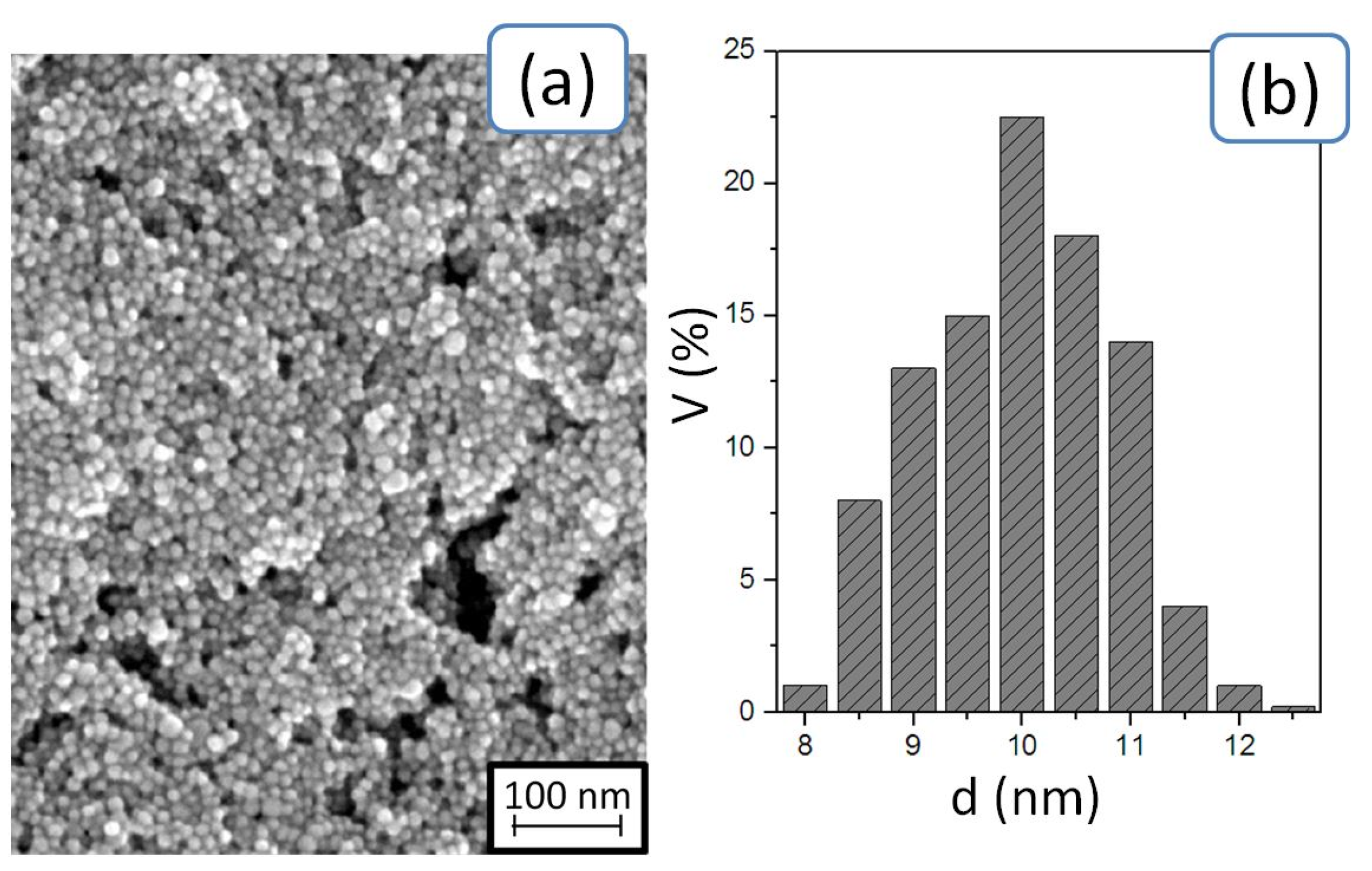

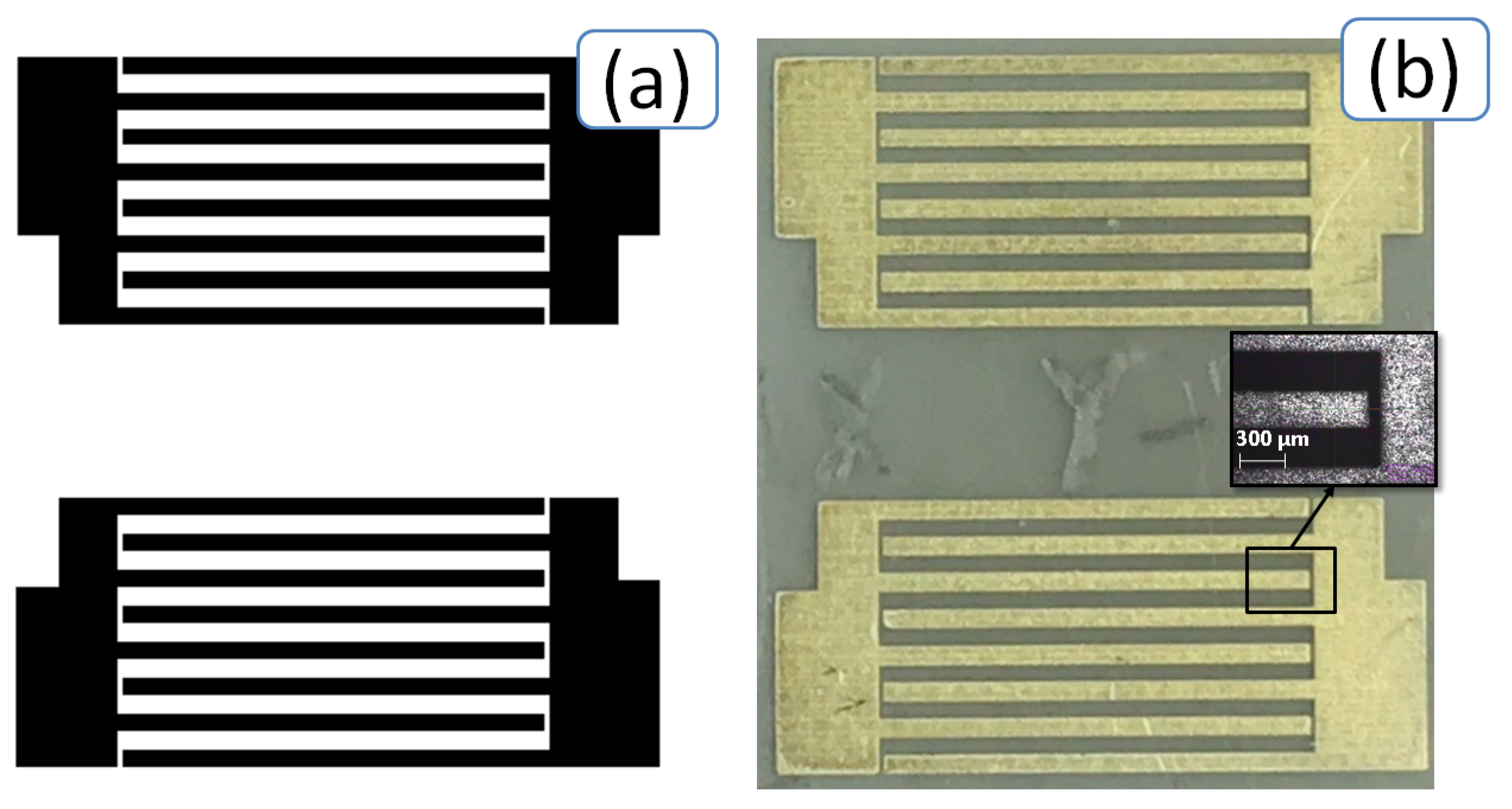


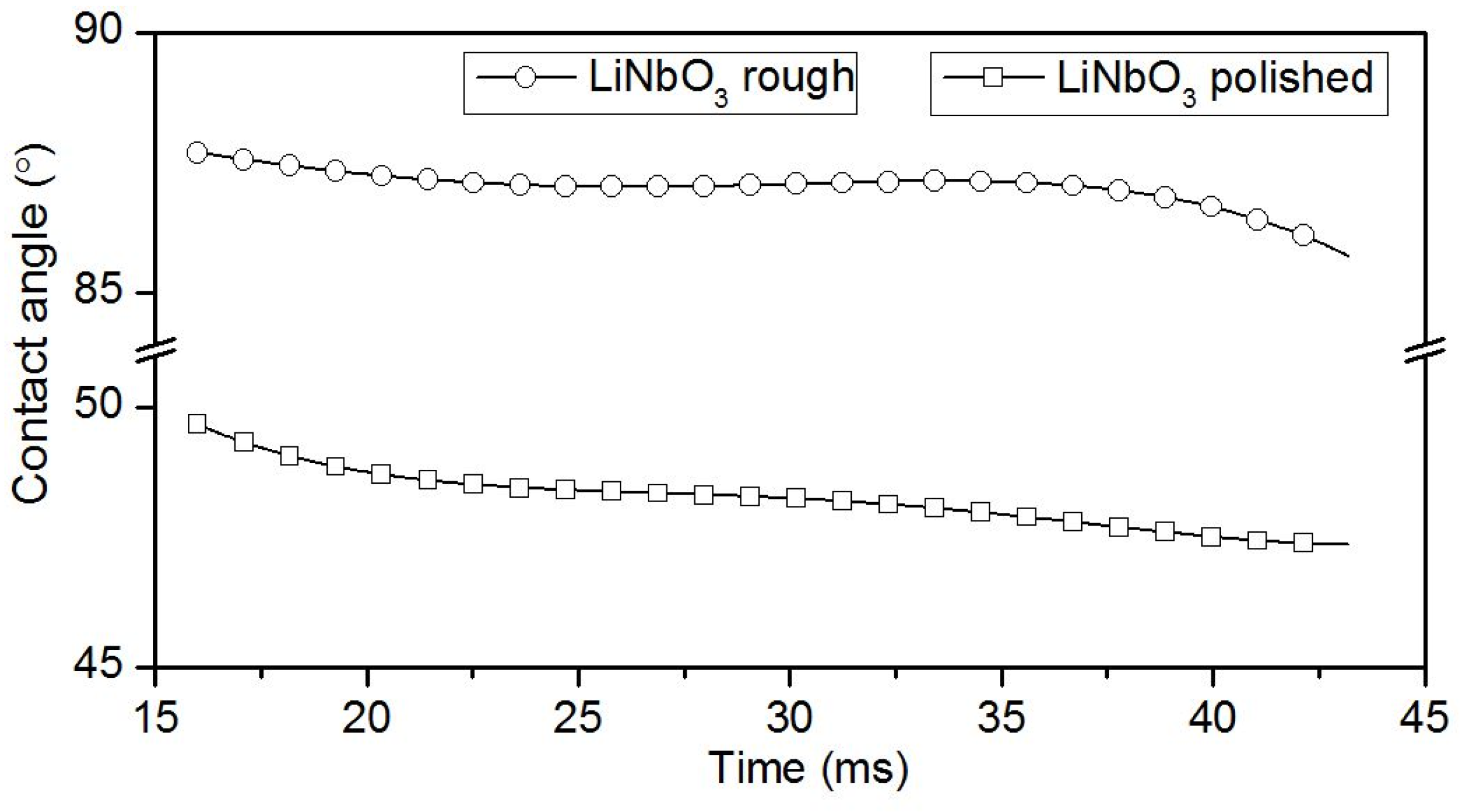
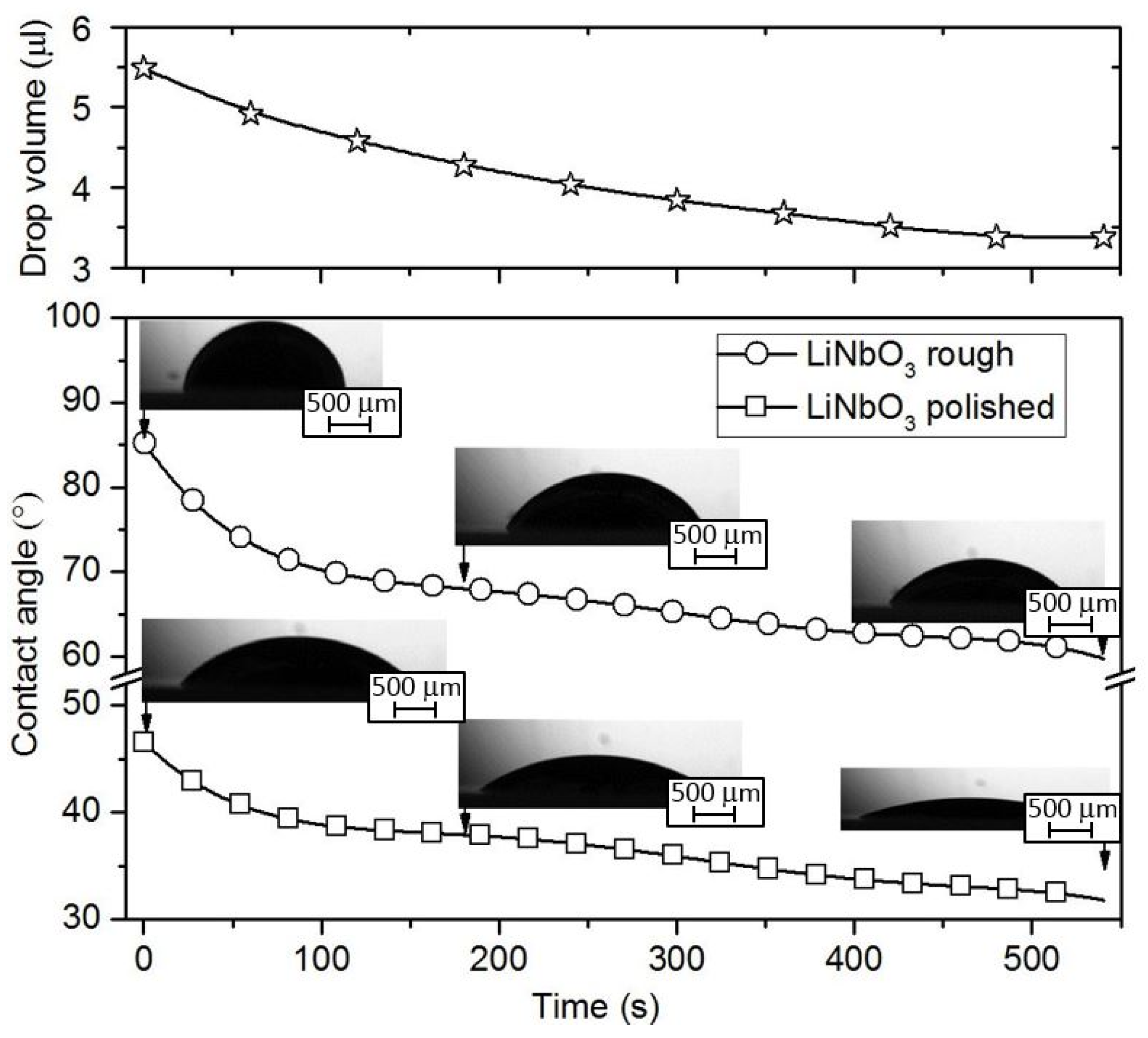

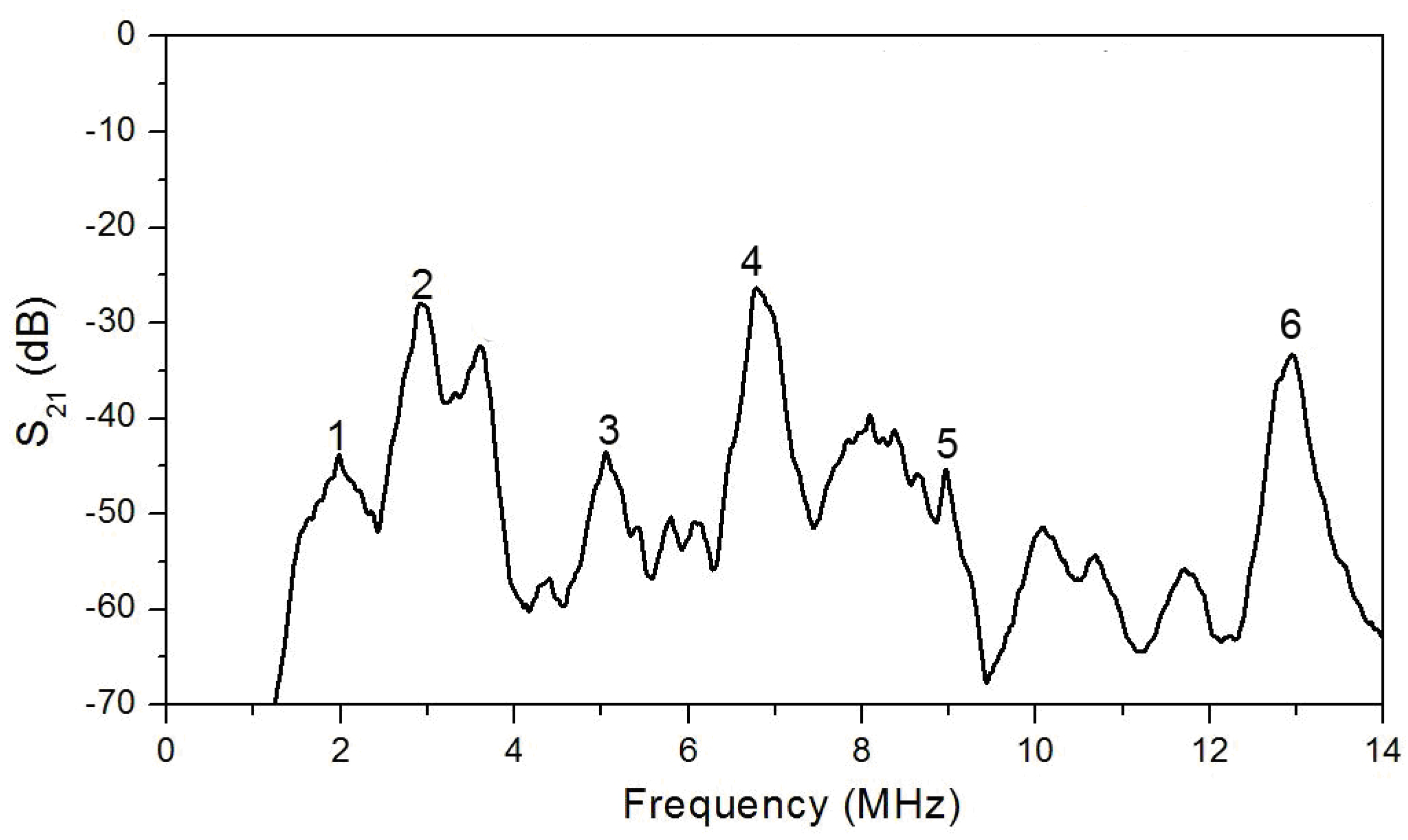

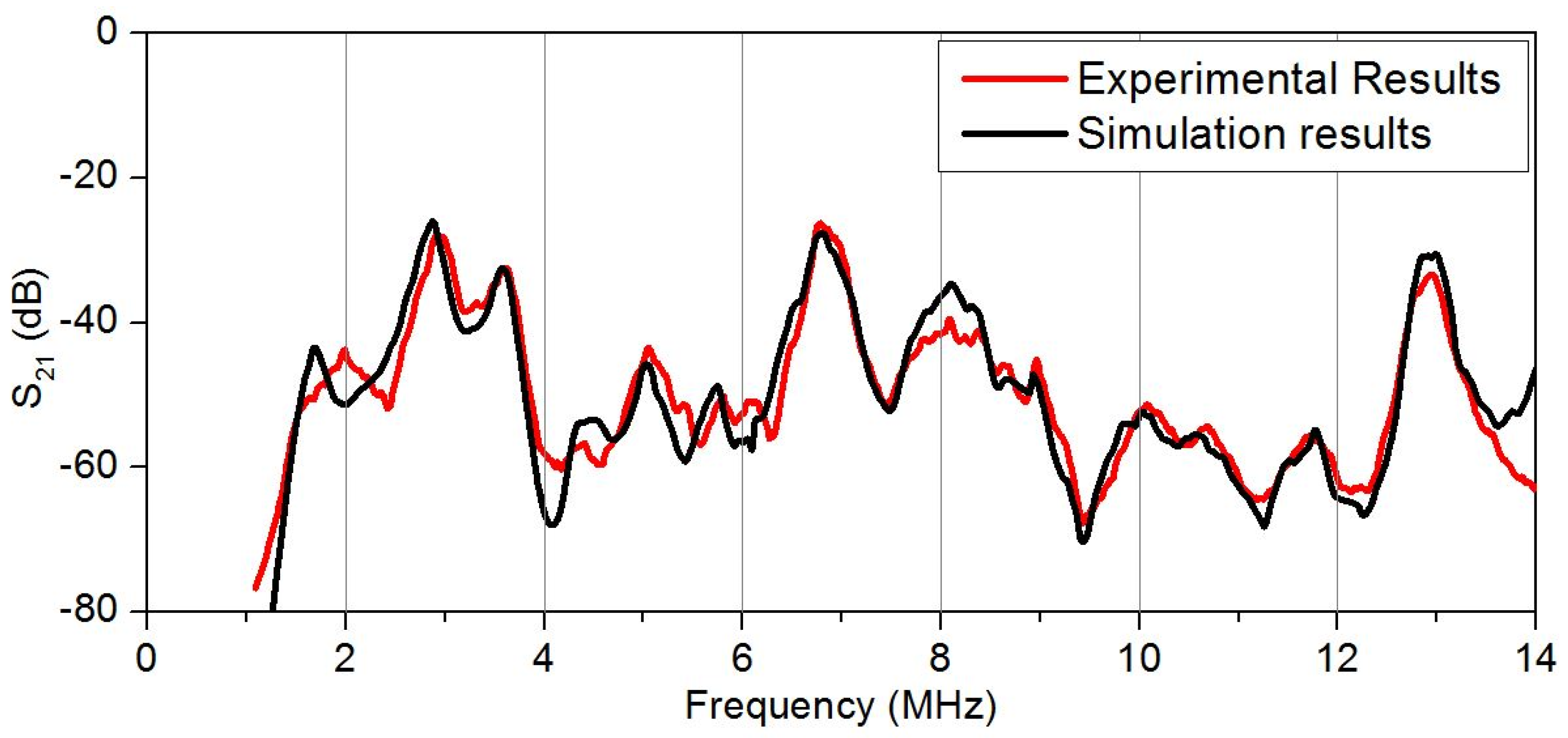
| Crystal Orientation, LiNbO3 | The Number of Pairs of Electrodes | Strip Width (µm) | Strip Thickness (µm) | Distance Between Strips (µm) | Distance Between IDT (µm) | Aperture (µm) |
|---|---|---|---|---|---|---|
| Y-cut X-propagation directionYX | 4 | 300 | 4 | 330 | 3030 | 7500 |
| Elastic modulii, CEij (1010 N/m2) | ||||||
|---|---|---|---|---|---|---|
| CE11 | CE12 | CE13 | CE14 | CE33 | CE44 | CE66 |
| 20.3 | 5.73 | 7.52 | 0.85 | 24.24 | 5.95 | 7.28 |
| Piezoconstants, eij (C/m2) | Dielectric permittivity, εSij/ε0 | Density (kg/m3) | ||||
| e15 | e22 | e31 | e33 | εS11 | εS33 | ρ |
| 3.83 | 2.37 | 0.23 | 1.3 | 44.3 | 27.9 | 4650 |
| Peak Number | Wave Type | Vph (m/s) | k2 (%) |
|---|---|---|---|
| 1 | A0 | 2467 | 6.0 |
| 2 | SH0 | 4506 | 27.0 |
| 3 | S0 | 6473 | 1.2 |
| 4 | SH1 | 9034 | 10.8 |
| 5 | A1 | 11,423 | 2.2 |
| 6 | SH2 | 16,327 | 1.2 |
© 2020 by the authors. Licensee MDPI, Basel, Switzerland. This article is an open access article distributed under the terms and conditions of the Creative Commons Attribution (CC BY) license (http://creativecommons.org/licenses/by/4.0/).
Share and Cite
Kuznetsova, I.; Smirnov, A.; Anisimkin, V.; Gubin, S.; Signore, M.A.; Francioso, L.; Kondoh, J.; Kolesov, V. Inkjet Printing of Plate Acoustic Wave Devices. Sensors 2020, 20, 3349. https://doi.org/10.3390/s20123349
Kuznetsova I, Smirnov A, Anisimkin V, Gubin S, Signore MA, Francioso L, Kondoh J, Kolesov V. Inkjet Printing of Plate Acoustic Wave Devices. Sensors. 2020; 20(12):3349. https://doi.org/10.3390/s20123349
Chicago/Turabian StyleKuznetsova, Iren, Andrey Smirnov, Vladimir Anisimkin, Sergey Gubin, Maria Assunta Signore, Luca Francioso, Jun Kondoh, and Vladimir Kolesov. 2020. "Inkjet Printing of Plate Acoustic Wave Devices" Sensors 20, no. 12: 3349. https://doi.org/10.3390/s20123349








